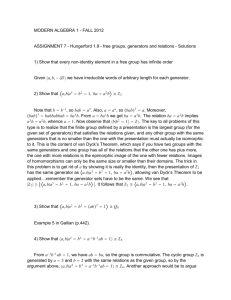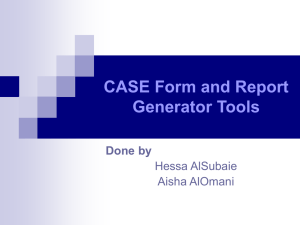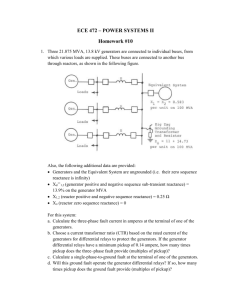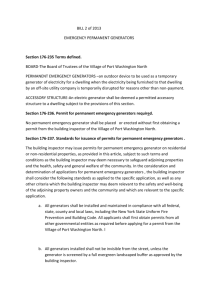Interdependences Between Technical, Economic and Environmental Changes:
advertisement
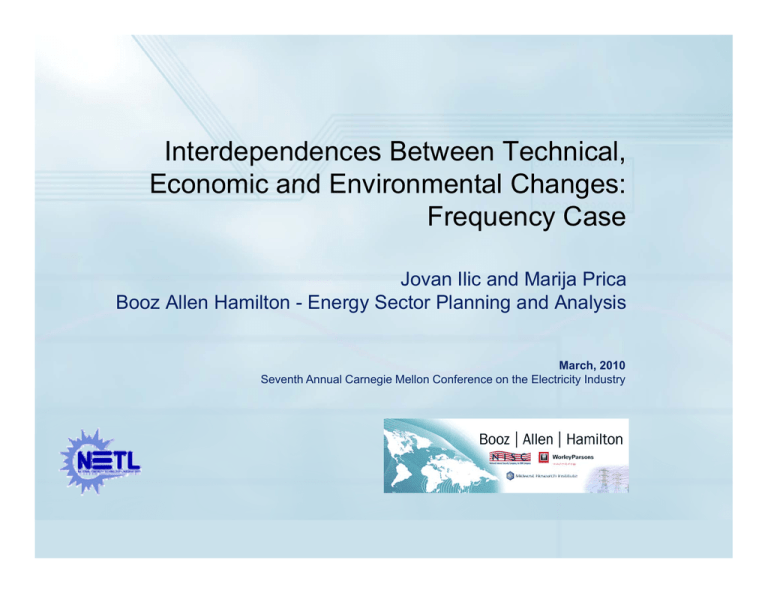
Interdependences Between Technical, Economic and Environmental Changes: Frequency Case Jovan Ilic and Marija Prica Booz Allen Hamilton - Energy Sector Planning and Analysis March, 2010 Seventh Annual Carnegie Mellon Conference on the Electricity Industry Acknowledgment This work was funded by the US Department of Energy's National Energy Technology Laboratory. Authors would like to thank Maria Hanley and Steve Bossart of NETL for comments. 1 Outline Technical, Economic and Environmental Interdependences q y response p Technical basics of frequency Standards and regulations affecting technical performance What has and is being done to address issues Conclusions and recommendations 1 Technical, Economic and Environmental Interdependences Generation planning is under pressure to satisfy different technical, economical and environmental requirements – Distributed g generation – smaller g generators units closer to end-users – Profit maximization – choice between different markets – Renewable generation – increased number of intermittent resources – GHG reduction d i Demand moves from rotational machines towards power electronic Both changes in supply and demand characteristics impact frequency response Frequency deviations from 60Hz can damage Prime movers (steam turbines, nuclear power plants) C Consumers’ ’ equipment i t Unaddressed frequency disturbances can cause blackouts I the Is th power system t ready d for f the th future f t changes? h ? 3 Smaller generation/demand power mismatches causing the same frequency q y disturbances If β is extrapolated to 2010, it would be 2500MW/0.1Hz: loss of a single large generator (1300MW) would cause 0.05Hz (normal limit in EI) frequency drop. 4 Is there a frequency problem or not? Supporters for both yes and no Nobody denies the frequency response deterioration What is causing the frequency response deterioration? Are there any indirect causes such as policies and regulations? What is done to improve frequency response? Can frequency be controlled if natural frequency response, declines significantly? 5 Frequency control hierarchy S Source: S Slides ffor FR Technical Conference, C f Office Off off Electrical Reliability, September S 2010 6 Outline Technical, Economic and Environmental Interdependences q y response p Technical basics of frequency Standards and regulations affecting technical performance What has and is being done to address issues Conclusions and recommendations 7 Frequency Deviations Causes Frequency deviations caused by mismatch between generation and demand – Demand higher or lower than the generation – S Scheduled h d l d power exchanges h b between t areas hi higher h or llower th than actual t l exchange Frequency q y control can restore g generation/demand balance without restoring g frequency L dLoad Load L d Losses 60 Export POWER CONSUMED OW CONSU 59 Generation Import 61 62 58 POWER SUPPLIED 8 An interconnection frequency is affected by … Interconnection’s moment of inertia Load types Generation control practices Types of reserves and their availability Monitoring Standards and regulatory issues 9 Interconnection’s Moment of Inertia Large moment of inertia of running generators during a disturbance keeps generators running Large moment of inertia of generators starting up or changing their output set points during the frequency restoration slows down the restoration Large coal power plants provide large inertia and improve frequency response Mostly smaller CC plants have been built during the last 15 years Kinetic energy of the system has effect on frequency response not the moment of inertia 1 2 Ek = I ω 2 Wind generators have significant moment of inertia (large R) Wind generators have less significant effect on the frequency response because of their low rotational speed If the system system’ss moment of inertia is known, frequency response to power mismatch could be calculated. 10 Load Types and Frequency Response Industrial loads – heavy rotating machinery, inductive heating Residential – small rotating devices, digital electronics Commercial – medium size rotating devices devices, digital electronics 39% Percent of Tota P al Sale [%] 37% 35% Residential Commercial Industrial 33% 31% 29% 27% 25% 1997 1998 1999 2000 2001 2002 2003 2004 2005 2006 2007 2008 Energy Information Agency (EIA), “Electricity,” Table 7.2. Retail Sales and Direct Use of Electricity to Ultimate Customers by Sector, by Provider, 1997 through 2008 http://www.eia.doe.gov/cneaf/electricity/epa/epat7p2.html (accessed on 9/12/2010). 11 Generator Control Practice Generators larger than 10MW are recommended to participate in governor (fast primary) control Primary frequency control is required by some IOSs Recommended generator droop characteristics is 5% for generators of all sizes in all interconnections ISOs in different interconnections require different spinning reserves for governor control Generators can choose control schemes There is no ancillary services market for governor control There is ancillary service market for Automatic Generation Control (AGC) capacity G Generator t operation ti practices ti detrimental d ti t l to t frequency f control t l – Steam turbine sliding pressure control – Nuclear power plant-blocked governor control – Combined cycle exhaust temperature control – Combined cycle positive frequency feedback 12 160 140 120 08/01/2010 01 08/01/2010 05 08/01/2010 09 08/01/2010 13 08/01/2010 17 08/01/2010 21 08/02/2010 01 08/02/2010 05 08/02/2010 09 08/02/2010 13 08/02/2010 17 08/02/2010 21 08/03/2010 01 08/03/2010 05 08/03/2010 09 08/03/2010 13 08/03/2010 17 08/03/2010 21 08/04/2010 01 08/04/2010 05 08/04/2010 09 08/04/2010 13 08/04/2010 17 08/04/2010 21 08/05/2010 01 08/05/2010 05 08/05/2010 09 08/05/2010 13 08/05/2010 17 08/05/2010 21 08/06/2010 01 08/06/2010 05 08/06/2010 09 08/06/2010 13 08/06/2010 17 08/06/2010 21 08/07/2010 01 08/07/2010 05 08/07/2010 09 08/07/2010 13 08/07/2010 17 08/07/2010 21 Price [$/MWh]] Generation Reserves Different regions have different minimum operating reserves requirements In deregulated environments economics interferes with reliability – Ancillary services market – Profit margin optimization Hourly Regulation and Energy Prices in PJM RMCP ($/MWh) LMCP [$ [$/MWh]] 100 80 60 40 20 0 Data Source: PJM 13 Monitoring and Regulation Interconnection Reliability Authority Coordinator1 Balancing Authority1 ...... . ....... Automatic Generator Control1 ..... 14 Reliability Authority Coordinatorn Balancing Authoritym Automatic Generator Controlk Outline Technical, Economic and Environmental Interdependences q y response p Technical basics of frequency Standards and regulations affecting technical performance What has and is being done to address issues Conclusions and recommendations 15 Standards and Regulations Effects on Frequency Stability Frequency F response greatly tl affected ff t d by b indirect i di t factors f t NERC has not well defined primary control objectives and performance criteria Ancillary market regulations allow for economic performance optimization before reliability requirements are met. FERC issued iss ed a n number mber of orders changing generation portfolio from large large, centralized, mostly coal based to small distributed generation. FERC’s orders also affected transmission investment incentivizing g small generation. 16 NERC Standards and Regulations The first set of 83 mandatory reliability standards was approved by FERC Order No. 693 in 2007 Resource and Demand Balancing (BAL) standards relevant to maintaining frequency at 60 Hz: – BAL-001 - Real Power Balancing Control Performance – BAL-002 - Disturbance Control Performance – BAL-003 - Frequency Response and Bias – BAL-004 - Time Error Correction – BAL-005 - Automatic Generation Control NERC plans on issuing a Recommendation to the Governor Owners and Generator Operators so that they report back to NERC on their operating status with respect to: – governor installation – governors free to respond – governor droop – governor limits 17 FERC Actions Shaping the Deregulated Industry Created market entry points for distributed generators – Order 888: Created access to transmission assets and markets – Order 889: Provided access to information required to succeed in markets – Order 2000: Established RTO to assure fair access – Order 529: Facilitated accumulation of financial and intellectual capital – Order 2003 (LGIP): Established interconnection agreements and protocols for new generation including asynchronous (e.g., wind) sources – Order 2006 (SGIP): Established favorable interconnection agreements and protocols for small g p generators Reprioritized investment criteria favoring distributed generations – Generator G t has h no economic i iinterest t t in i ttransmission i i reliability li bilit – Generator has no economic incentive to invest in transmission assets – Generator has economic incentive to be closer to customers 18 Outline Technical, Economic and Environmental Interdependences q y response p Technical basics of frequency Standards and regulations affecting technical performance What has and is being done to address issues Conclusions and recommendations 19 What has been done so far? FERC and NERC actively work on some of technical problems recognized in this study Technical standards are being actively developed developed, mostly based on experience of well functioning interconnections and ISOs Deregulated market designs usually did not sufficiently account for reliability 20 Outline Technical, Economic and Environmental Interdependences q y response p Technical basics of frequency Standards and regulations affecting technical performance What has and is being done to address issues Conclusions and recommendations 21 Conclusion There Th is i di disconnectt b between t market k td design i and d ttechnical h i l iissues, h hard d problem made even harder Deregulated industry has incentives to build smaller generators Reliability and transmission capacity concerns removed from generation Spinning reser reserves es for primar primary control based on a g guess. ess Primary control parameters and performance criteria not defined. Primary control not enforced 22 Recommendations Develop better understanding of system’s natural frequency response Actively measure and/or estimate system’s natural frequency response in real time Benefits of different droop characteristic for different size generators should be evaluated Design theoretically sound primary control strategy and algorithms based on spatial and temporal characteristics of the system Based on the above three points, define primary control parameters and objectives primary y control p performance Enforce p Design a primary control spinning reserve market 23 Questions? 24



